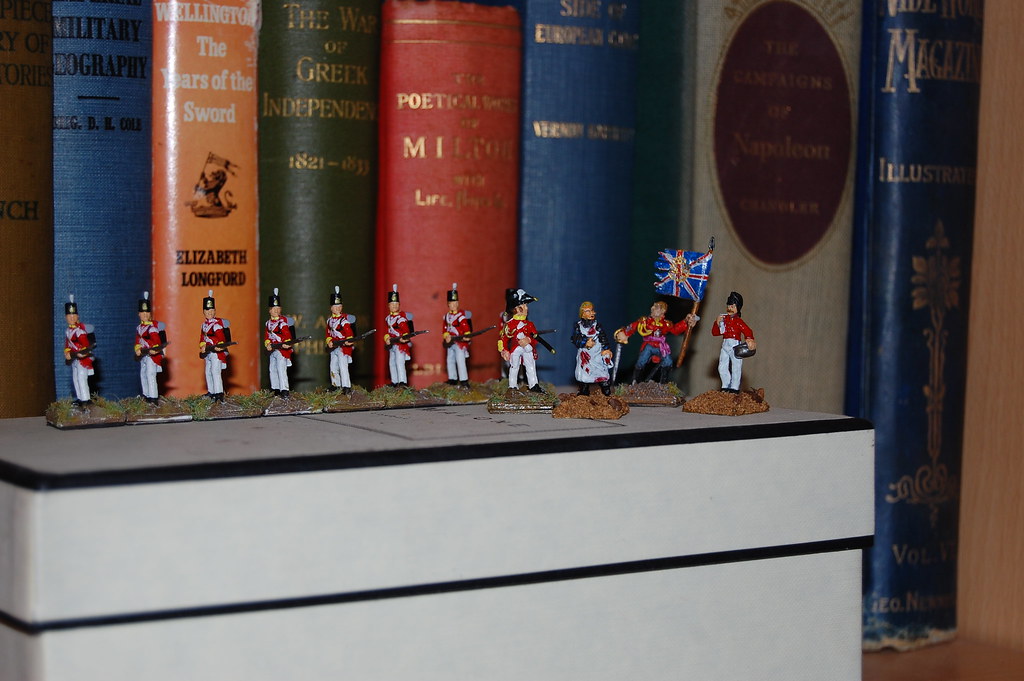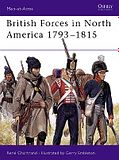
Officers and Men of the 46th Regiment of Foot on parade at the East Wall Barracks.
To the rear: Enlisted men in the regiment.
Foreground(left to right):
Captain Chatham, Ensign (& acting surgeon) Hanson, Lieutenant McIntyre, Toby (surgeon's orderly & assistant to Mr. Hanson).
(Hanson & Toby painted by Mr. E, McIntyre painted by Mr. C)
Large picture, click to enlarge.
To the rear: Enlisted men in the regiment.
Foreground(left to right):
Captain Chatham, Ensign (& acting surgeon) Hanson, Lieutenant McIntyre, Toby (surgeon's orderly & assistant to Mr. Hanson).
(Hanson & Toby painted by Mr. E, McIntyre painted by Mr. C)
Large picture, click to enlarge.
The 46nd Regiment of Foot (The Royal Corps Of Halberdiers, West Essex Regiment)
Founded: 1590
Battle Honours: Edinburgh Castle 1746, Louisbourg 1750, Quebec 1750
(in black), Sainte-Foy 1760, Lexington 1775, Concord 1775, Bunker Hill
1775, Montevideo 1807.
Motto Honi Soit Qui Mal Y Pense (Evil to He Whom Evil Thinks)
Facings – Yellow.
Officer Lace – Silver with a black line.
The 46nd Regiment of Foot (The Royal Corps Of Halberdiers) is, as you well know, the finest regiment on God's green earth. The regiment comprises of three battalions: The 1st (Service), 2nd (Depot) and 3rd (Fencibles).
The Halberdiers are commanded by an officer called a 'Captain-Commandant' - a rank derived from the Corp's origins as the Earl Of Essex's Honourable Company Of Free Halberdiers during the reign of Elizabeth I. The current Captain-Commandant is Sir Julian West, an old Tory with a mania for music.
The company first saw action in the Irish wars, but the regiment as it exists now first saw war service during the 1745 Jacobite Rising against rebels who had risen in support of Bonnie Prince Charlie who claimed the thrones of the Kingdom of Great Britain and Ireland. The regiment under Sir John Cope marched north into the Scottish Highlands but, as he thought the rebel force to be stronger than it really was, avoided engaging the Jacobites then sailed from Aberdeen down to Dunbar to meet the Jacobite forces to the east of Edinburgh at the Battle of Prestonpans
which saw the Government forces routed by the Jacobites. The regiment subsequently took part in the defence of Edinburgh Castle which never capitulated to the Jacobite rebels during Bonnie Prince Charlie's control of the city of Edinburgh. The Jacobite Rebellion was eventually crushed by Government forces in 1746 and Charles was forced to escape to France.
In 1750 the regiment deployed to Nova Scotia, Canada and the following year it was numbered the 46nd Regiment of Foot. The regiment took part in the Seven Years' War while in Canada, seeing action against the French-held Fortress Louisbourg during the 48-day Siege of Louisburg,
a siege that culminated in a French surrender. The following year the Halbardiers took part in the legendary Battle of Quebec which saw British forces, under the command of General James Wolfe, prevail again French forces in a battle that concluded a 3-month siege of Quebec. Wolfe was well-respected by his men, to such an extent that to commemorate the death of Wolfe in the battle the Halbardiers began wearing a black line in their lace.
In 1760 the Halbardiers took part in the Battle of Sainte-Foy, a British defeat against the French during the British defence of Quebec though despite the defeat the British held onto it. In 1763 the regiment returned home from its long deployment in North America with the conclusion of
Britain's war with France. It arrived in North America in 1773 in New Jersey, a colony of the Great Britain and which would be one of the "Thirteen Colonies" that would soon revolt against British rule. In late 1774 the regiment was deployed to Boston and the following year the regiment saw action against rebels at Lexington and Concord and in the Battle of Bunker
Hill which saw a British victory but at heavy cost.
In 1776 the regiment returned to Quebec to assist in the defence of it from American rebels. In 1777 the regiment was part of the disastrous expedition to Saratoga where it took part in a number of major engagements. The Halbardiers became internees after the surrender of
British forces on the 17 October. It did not return home from its enforced stay until 1783 and the conclusion of the American War of Independence.
In 1782 the regiment was given a county distinction when it was given the title the 46th (The Royal Corps Of Halberdiers, West Essex Regiment) Regiment of Foot. In 1790 the regiment returned to the Western Hemisphere once again where it garrisoned a number of islands
in the West Indies during the French Revolutionary War. In 1794, a third battalion was raised in Essex as part of the invasion scare that was sweeping the country, but was disbanded soon after.
In 1803 the 3rd Battalion was raised again and the following year deployed to Ireland.
In 1806 the 1st Battalion arrived in the Cape of Good Hope to undertake garrison duties in the territory captured from the Dutch.
That year an unsuccessful, and unauthorised, expedition to the French allies Spain against its South American possessions, led by Sir Home Riggs Popham, took place.
The following year the 1st Battalion was part of the second-invasion force, led by Brigadier-General Sir Samuel Auchmuty, who was unaware of the failure of the first-invasion. The 1st Battalion took part in the siege and subsequent storming of Montevideo (now capital of
Uruguay), which culminated in the capture of the city on the 3 February.
The Halbardiers also saw action in July during the mis-managed attempt to capture Buenos Aires (now capital of Argentina) from the Spanish. The attempt to capture the city failed and the British force was soon surrounded and forced to surrender.
The 1st Battalion eventually arrived in Spain in 1808 as part of Sir. John Moore's army sent to support the Spaniards uprising against the French.
Regimental Traditions
Halberds
As befits the regiments origins, Halberds are a recurring theme. The regimental colour shows a lion over crossed Halberds. All company sergeants are required to carry them. The Ensign assigned the company colour, traditionally attaches it to a Halberd though this is not required by regulations. It is laid down in the standing orders of the regiment, that any colour party must have at least two men armed with Halberds and trained in their use. Such training also forms a part of the breaking in of any new ensigns assigned to the regiment.
Black Line
Officers wearing lace at their cuffs are asked to put a line of black through it in remembrance of the death of Wolfe.
Wren Day
A relatively recent development and a hangover from the Regiments time in Ireland. On St. Stephen's Day, six men chosen from each company are dressed as Wren Boys and carrying the youngest of the company's Ensigns on the shoulders walk from company mess to company mess, where they entertain the troops with songs, amateur theatricals and comic turns and are fed and entertained in turn. The first man who can bring a live wren to the Commandant on Wren Day is given a guinea. The guinea lodged on account with the Regimental commissary is to purchase
food and drink (mostly drink) for the lucky man's mess.
Port Fines
Newcomers to the Halbardiers often find the rules of the Mess strange and arcane. Thus far you've only learned that the youngest officer in the Mess must be referred to as "Boots."
Breaches of Mess etiquette are punished by the fine of a bottle of port to the common fund, a
fact that causes no end of anxiety for officers forced to live on their pay.
Regimental Organisation
The Regiment is made up of three battalions, the first battalion (service), the second battalion (depot) and the third battalion (fencibles).
You are all with the first battalion, the service battalion which does the actual fighting.
The second battalion is a depot or holding battalion based in Ledgewidge, West Essex. The depot battalion gathers recruits, trains them and sends them in drafts to replace the losses in the first
battalion.
The third battalion is a battalion of fencibles. A short of home guard outfit raised from the local area to defend Britain in case of invasion from France.






































A very nice history of the regiment. Good work.
ReplyDelete-- Jeff
http://saxe-bearstein.blogspot.com/
Good Morning,
ReplyDeleteThis looks like a great start to your new blog. Lots of interesting and engaging narrative, well-painted figures, and a rather nice collection of book titles in the background! The pipe is a nice touch as well.
Best Regards,
Stokes
Thanks for the encouragement guys. Which reminds me, I didn't paint all the figures. Better sort that out with an edit.
ReplyDelete